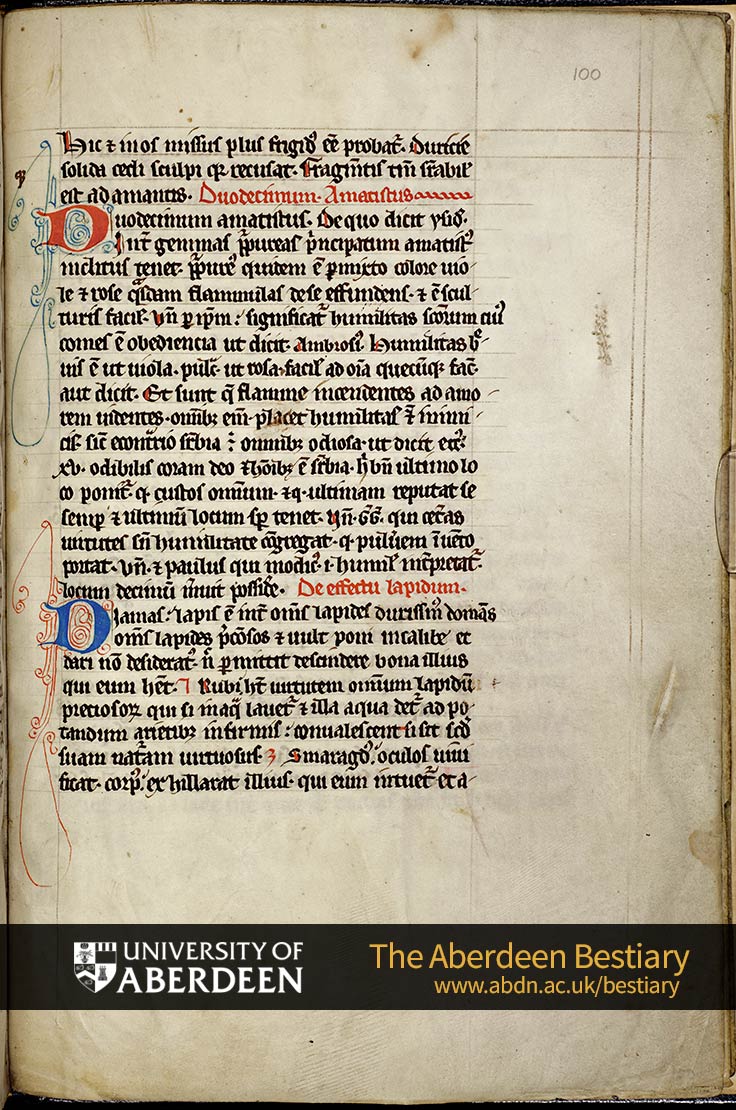Folio 100r - Duodecimum Amatistus; The twelfth, amethyst. De effectu lapidum; Of stones and what they can do.
This stone, placed in the mouth, proves to be colder than others. It is very hard and resists cutting or engraving. But it can be marked by a fragment of diamond.
The twelfth, amethyst
The twelfth foundation is amethyst. Isidorus says of it: Among purple stones, the Indian amethyst holds first position; it is, indeed, purple but of mixed coloration, giving forth violet and rose-coloured lights; it is easy to engrave. For this reason the humility of the saints is signified by it; associated with humility is obedience, as Ambrose says: 'Humility is small, like the violet, beautiful like the rose, easy to apply to all things'; or: 'They are like burning flames, looking at love'. For humility is acceptable to everyone, even to our enemies; as pride, in contrast, is viewed by everyone with detestation, as it says in Ecclesiasticus, 15: 'Pride is hateful before God and men' (see 10: 7). For this reason the amethyst is placed in the final position, as if watching over all, and as if humility always reckons itself the least and always takes the last place. In this context, Gregory: 'He who assembles in himself the other virtues without humility is like one who carries dust in the wind. Also Paul: 'He who is modest, that is to be understood as humble, deserves to possess the tenth place.'
Of stones and what they can do
The diamond is amongst all stones the hardest, cutting all other precious stones; it likes to be set in steel; it does not wish to be given away; and it will not allow the goods of him who possesses it to be divided.
2 The ruby has the virtue of all precious stones, that if it is washed in water and that water is then given to the sick who are thirsty, they grow well if each one is according to his nature virtuous.
3 The smaragdus refreshes the eyes; it cheers the body of him who looks upon it; and
- Commentary
-
Commentary
Text
Amethyst. The properties of various gems.
Comment
Initials type 4.
Folio Attributes
- Transcription and Translation
-
Transcription
Hic et in os missus plus frigidus esse probatur, Duricie\ solida cedi sculpi quia [que] recusat, Fragmentis tamen superabilis est adamantis.\ Duodecimum Amatistus\ Duodecimum amatistus. De quo dicit Ysidorus:\ Inter gemmas purpureas principatum amatistus\ inclitus [Indicus] tenet, purpureus quidem est permixto colore vio\le et rose quasdam flammulas de se effundens, et est scul\turis facilis, unde per ipsum, significatur humilitas sanctorum cuius\ comes est obediencia ut dicit Ambrosius: Humilitas bre\vis est ut viola, pulchra, ut rosa, facilis ad omnia quecumque facere;\ aut dicit: Et sunt que flamme incendentes ad amo\rem videntes, omnibus enim placet humilitas etiam inimi\cis, sicut econtrario superbia est omnibus odiosa, ut dicit Ecclesiasticus,\ xv: Odibilis coram deo et hominibus est superbia. Hic unde ultimo lo\co ponitur quasi custos omnium, et quasi ultimam reputat se\ semper et ultimum locum semper tenet. Unde Gregorius qui ceteras\ virtutes sine humilitate congregat quasi pulverem in vento\ portat. Unde et Paulus: Qui modicus, id est humilis interpretatur,\ locum decimum meruit possidere. \ De effectu lapidum \ Diamas, lapis est inter omnes lapides durissimus domans\ omnes lapides preciosos et vult poni in calibe et\ dari non desideratus nec permittit descindere bona illius\ qui eum habet. Rubi habet virtutem omnium lapidum\ preciosorum qui si in aqua lavetur et illa aqua detur ad po\tandum arietibus [arentibus] infirmis, convalescent si sit secundum\ suam naturam virtuosus. Smaragdus, oculos vivi\ficat, corpus exhillarat illius, qui eum intuetur et a\Translation
This stone, placed in the mouth, proves to be colder than others. It is very hard and resists cutting or engraving. But it can be marked by a fragment of diamond. The twelfth, amethyst The twelfth foundation is amethyst. Isidorus says of it: Among purple stones, the Indian amethyst holds first position; it is, indeed, purple but of mixed coloration, giving forth violet and rose-coloured lights; it is easy to engrave. For this reason the humility of the saints is signified by it; associated with humility is obedience, as Ambrose says: 'Humility is small, like the violet, beautiful like the rose, easy to apply to all things'; or: 'They are like burning flames, looking at love'. For humility is acceptable to everyone, even to our enemies; as pride, in contrast, is viewed by everyone with detestation, as it says in Ecclesiasticus, 15: 'Pride is hateful before God and men' (see 10: 7). For this reason the amethyst is placed in the final position, as if watching over all, and as if humility always reckons itself the least and always takes the last place. In this context, Gregory: 'He who assembles in himself the other virtues without humility is like one who carries dust in the wind. Also Paul: 'He who is modest, that is to be understood as humble, deserves to possess the tenth place.' Of stones and what they can do The diamond is amongst all stones the hardest, cutting all other precious stones; it likes to be set in steel; it does not wish to be given away; and it will not allow the goods of him who possesses it to be divided. 2 The ruby has the virtue of all precious stones, that if it is washed in water and that water is then given to the sick who are thirsty, they grow well if each one is according to his nature virtuous. 3 The smaragdus refreshes the eyes; it cheers the body of him who looks upon it; and

